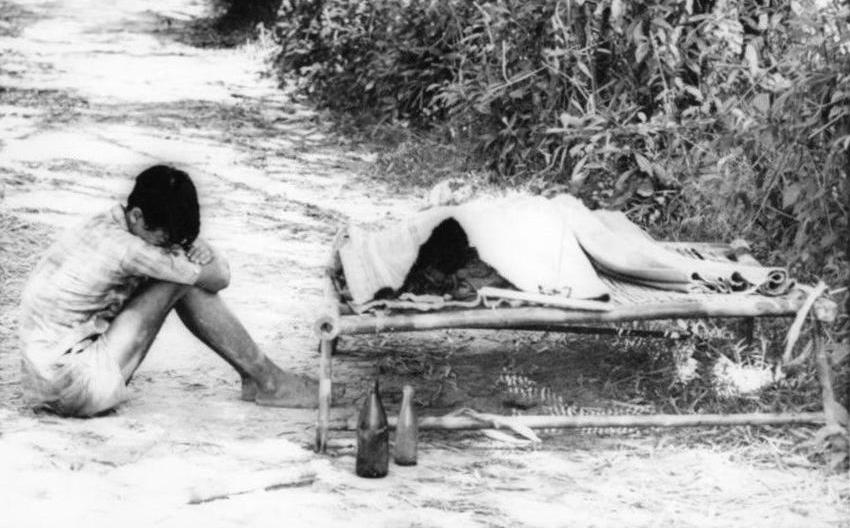
Vietnam War: The Việt Cộng

Figure 1.--The Anti-War Movement in the United States prtrayed America as an aggressive country committing terrible attrocities. Many idealized the Việt Cộng and the North Vietnamese as freedom fighters. Commonly ignored was the otherside of this equation. The press caption here read, "Boy Weeps for Slain Mother: A 17-year old South Vietnamese boy weeps over the body of his slain mother, placed on a bamboo bed on jungle road at Than Lam village after she was shot through the neck by the Viet Cong last week. Three days before when the Viet Nam militia and U.S. Marines had patrolled the area, the woman told of Viet Cong that came refularly to the village. The same night th Viet Cong returned to the village and an informer told them what the woman had done. The Viet Cong forced her to kneel and shot her." The photograph was dated July 12, 1966.
|
|
The Việt Cộng was the name used by the Western Media for the National Liberation Front (NLF) in South Vietnam. North Vietnam founded the NLF (1960) for the task of launching an insurgency in the South. The Việt Cộng's core members were largely volunteer 'regroupees'. They were southern Viet Minh who had fought against the French amd then moved to the Communist North after the Geneva Accord which divided Indochina (1954). The Nort Vietnamese army provided the regroupees military training and sent them back south. The NLF was the political organization. It's military force was the People's Liberation Armed Forces of South Vietnam (PLAF). After the Frech left Indochina, Vietnam was divided between a Communist north and a non-Communist south. Many non-Communists south fled the north to the south. After taking over in the south, the Communists conducted widespread executions of land owners, anti-Communists, Catholics, and others. NLF was from the beginning a creature of the Communist north. The PLAF had both guerrilla and regular army units. They also organized a network of cadres who organized peasants in the rural areas over which it establshed cntrol using tactics perfected by Mao in China and then Ho in North Vietmam. They used patriotic appeals as well as socialist teaching. For those who resisted terror was also used. The South Vietnamese Goverment attempted to appeal the peasatry as well, but with less success. Communist forces were under a single command structure set (1958). [MHIV, p. 68.] In the United States as the War in Vietnam developed, attempted to portray the Viet Cong insisted the Việt Cộng as an indigenous insurgency in the south. There is little evidence of this. From early stages it was fomented, organized and supplied by North VietNam. The supply line from the North became known as the Ho Chi Minh Trail and a major issue in the War. The NLF program called for southern Vietnamese to 'overthrow the camouflaged colonial regime of the American imperialists' and to make 'efforts toward the peaceful unification'. The South Vietnamese Army (ARVN) wa hard pressed to defeat the Viet Cong until the United states intervened in frce (1965). The PLAF's great military action was the Tet Offensive (1968). This was a country-wide on the more than 100 South Vietnamese urban centers. This included the U.S. embassy in Saigon. The Tet Offensive caught the attention of world's media and portrayed in virtual every American living room via the evening news. The result ws that the PLAF was virtually destroyed. This was not what American journalists told the American people. The media message was that the American military had failed and that the Communists were as strong as ever. In fact, the fighting after Tet was largely carried by the North Vietnamese Army (NVA). After the American withdrawl and the U.S. Congress ended military suport to South Vietnam, The NVA defeated ARVN (1975). The NLF was disolved after North and South Vietnam were officially unified under a Communist government (1976).
Sources
Military History Institute of Vietnam (MHIV). Victory in Vietnam: The Official History of the People's Army of Vietnam, 1954–1975 Trans, Merle L. Pribbenow. (University Press of Kansas: 2002). (2002)
CIH

Navigate the Children in History Website:
[Return to Main Vietnam War page]
[Return to Main Vietnamese history page]
[Return to Main Vietnam page]
[About Us]
[Introduction]
[Biographies]
[Chronology]
[Climatology]
[Clothing]
[Disease and Health]
[Economics]
[Freedom]
[Geography]
[History]
[Human Nature]
[Ideology]
[Law]
[Nationalism]
[Presidents]
[Religion]
[Royalty]
[Science]
[Social Class]
[Bibliographies]
[Contributions]
[FAQs]
[Glossaries]
[Images]
[Links]
[Registration]
[Tools]
[Children in History Home]
Created: 1:30 PM 5/18/2016
Last updated: 1:30 PM 5/18/2016



